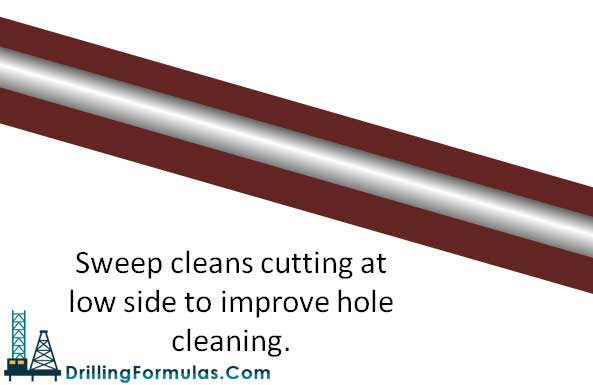Sweep is a mud which has higher rheology and/or more mud weight than current mud property. It is used to carry cutting that set at low side of a wellbore and it is widely used for Sea water drilling.

These illustration show how sweep works.
Cutting at the low side of the well bore (image below)

Sweep is pumped (image below).

Hole is clean (image below).

Note: In reality, the pipe is not in the exact center of the well but these illustrations are used to aid the understanding of how sweeps works.
This is a real case which will show you how the sweep helps hole cleaning.
Information
Drilling fluid – sea water
Sweep property:
Funnel Viscosity +/- 100 sec
PV = 25
YP = 34
Density = 10.0 ppg
Hole angle = 59 degree
Sweep volume = 50 bbl
Formation = sand stone, clay stone, clay, trace carbonate
Drilling parameters before pumping sweep
Pick up = 300 klb
Rotate weight = 250 klb
Slack off = 200 klb
Torque = 23,000 ft-lb
Drilling parameters after pumping sweep
Pick up = 280 klb
Rotate weight = 230 klb
Slack off = 190 klb
Torque = 20,000 ft-lb
It is clearly seen that sweeping the hole helps hole cleaning.
Before (Image below)

After (Image below)

Do you have any experience about pumping sweep?
Please feel free to share with us in the comment section.








Do not forget to switch return flow to slug prior Sweep on surface to avoid intervere with your mud shape
During my years as a Mudlogger/Data Engineer Hi Vis/Weighted sweeps were a very useful method of lag time check. As the sweep exits the bit there is an increase in SPP which gives the exact depth (which also confirms the short lag time from the pit) and with modern high definition mud weight sensors (coriolis type) you get a very easy to see increase in mud weight at the exact moment the sweep returns to surface (no trying to see rice or waiting for any gas peaks). This allows an accurate estimate of the actual well bore diameter and can be performed regularly during drilling the section to maintain the accuracy of all lagged data. It even shows if the hole is undergauge if the sweep comes up earlier than calculated.
That is completely right, additional to hole cleaning these points can be extract by pumping hi vis pill
This is a procedure that I normally follow:
XG Sweeps
1. Mix 1-2ppb Barozan (xanthan gum) in 30-60 bbls. of base fluid to obtain a 150 sec FV
2. Mix Barolift (microfiber) at 2-3/4# bags per 10 bbls of sweep or 0.15 ppb
3. Raise weight to 2+ppg above current base mud
4. Pump and shear to homogeneous mixture
5. Pump at maximum flow rate for hole size:
a. 12 ¼” hole: +/-900 gpm
b. 8 ½” hole: +/-600 gpm
6. Rotate pipe at 120 rpm to aid in breaking up cuttings beds. However, if there is a motor in the hole the rpm may be limited to 80-100 pp. Check with the motor tech.
7. Circulate until fiber is observed on screens and screens are relatively clean: +/-2.5 BU or equivalent strokes from start of sweep
8. Volume of sweep:
a. 12 ¼” hole: 60 bbls.
b. 8 ½” hole: 30 bbls.
This procedure is useful but I think with high vis like this (150sec) and high gmp (900) in 12 1/4″ hole in some fields should be careful about fracture pressure because of increasing in SPP due to pumping pill.
Just a quick question. Any reason why the Slack-off weight after pumping the sweep is almost 10 times higher than the initial slack-off (prior sweep pump)?
Of course while pumping hi vis pill due to creation of pistoning effect slack off will be higher but of course not 10 times, but During pumping pill &sweeping the well it doesn’t come to that to need slack off for me! can i ask what was the reason for you to slack off?
great clarification ,
thanks